FW
Taiwan showcased its industry’s artistry, including areas of eco-textiles, function and fashion textiles, dyes and trimmings at the Saigontex 2016 textile exhibition, concluded recently in Ho Chi Minh City. The Taiwan Textile Federation (TTF) endorsed the island’s distinctive sample at this year’s exhibits, under the theme, Think Taiwan for Textiles.
Saigontex 2016, was held at the Saigon Exhibition and Convention Center (SECC) from March 30 to April 2, and witnessed participation of 1,063 exhibitors from across 24 countries /regions. At the exhibition, TTF promoted the island’s textile industry under three broad categories of fashion, functionality and eco-friendliness.
Export of Taiwanese products to Vietnam has seen a significant growth in the recent years, owing to the country’s trade ties under ASEAN. Moreover, Taiwan has also expressed interest in joining the TPP, of which Vietnam is already a member. Taiwan also hopes to promote a proposed Free Trade Agreement of the Asia-Pacific (FTAAP) amid multilateral efforts to boost economic integration in the region.
TTF’s Textile Export Promotion Project (TEPP), organised by Taiwan’s Ministry of Economic Affairs’ Bureau of Foreign Trade, promotes the textile industry by organising trade missions, collaborating meetings and ensuring attendance at various international shows like Saigontex. The country’s textile product quality is evident in its partnerships with brands like Decathlon, Oasis, Thai Tuan, Garmex, Lime Orange, Vinatex, Poong In and Walmart.
In its recent report, ‘The Future of Dye Sublimation Printing to 2021’, Smithers Pira tracks the increased use of this technology across key end-use segments – signage, technical, household, and garments. The data demonstrates a strong year-on-year growth of 18.4% in the amount of material printed across the next five years. This in turn is projected to increase by over 100% of the volume and value of material that is dye sublimation printed across the study period.
Smithers Pira also forecasts approximately 900,000m2 of textiles be printed with the process by 2021, the global dye sublimation print market is anticipated to grow over double in the coming five years, creating a global market worth of nearly 3 billion euros ($3.4 billion) by 2021. The increase is attributed to the broader rise of digital inkjet systems in the textile trade.
Eventually, as the dye sublimation market booms, it will create several opportunities for ink and textile suppliers, press builders, and partners across the value chain. In its analysis, Smithers also identifies five major factors that will determine the dye sublimation print market’s growth through to 2021.
"Digital printing is likely to bring high volume printing opportunities to industries such as paper, industrial surfaces of all kinds and textile. These industries are reluctant to hop on the bandwagon usually due to each application’s particular drawbacks but in most cases manufacturers are simply oblivious to the availability of digital printing’s advantages and capabilities also for high volume industries."
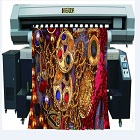
In today’s world, any printer can spurt out the advantages of digital printing over traditional printing. The graphic arts sector, signage and packaging industry are examples of industries which adopted digital printing technologies alongside traditional printing. Yet, some sectors are very slow to adapt to digital in spite of its advantages.
Digital printing is likely to bring high volume printing opportunities to industries such as paper, industrial surfaces of all kinds and textile. These industries are reluctant to hop on the bandwagon usually due to each application’s particular drawbacks but in most cases manufacturers are simply oblivious to the availability of digital printing’s advantages and capabilities also for high volume industries. In the textile industry, the majority of textile printing is done in traditional analogue method but there is a growing interest for digital printing on textiles. This demand may have emanated from dye sublimation printing on polyester achieved easily with a simple digital printer usually with the mediation of a transfer paper but the demand may have emanated from the textile industry’s latent acknowledgement of digital printing capabilities.
A necessity than an option
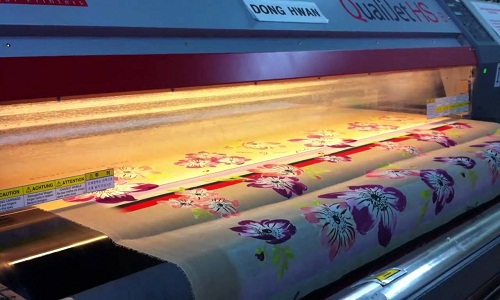
According to an industry experts, with each year passing the cost of digital printing is coming down. Very soon costs of digital printing and rotary will converge. Every year the difference is getting smaller. But the quality you get in digital you don’t get in any other form. It is impossible to get the same quality, color and depth in rotary or screen technology.
He opined that digital is environment-friendly, has no discharge, no waste. It is a totally green way of doing printing. We only print on the fabric where it is required. There is no testing or sampling required. You can print short run or long run.
Today, China is the world leader in digital printing in terms of volume. Whereas, Turkey is the leader in quality and volume put together. But India is catching up fast and it can bring the latest technology and the best pricing for customers.
Converting to digital is not an option. It is a necessity. And this is being done both for exports as well as for the domestic market.
Observed Mark Elvidge, Business Development Manager, Roland DG UK Ltd., Desk top printers have made things easy. Textile screens used to be made. It used to take 15 days to make a file. Colors were limited to eight or ten colors. Now we have 16 million colors. But, pricing is a problem. The difference is quite high. At one time the textile industry in India was dominated by small and medium units that had short runs and found this technology unviable. Now small orders of 20,000 or 30,000 meters are no big deal. At one time it used to be 500 or 1000 meters. Now, volumes have really gone high. In India there are about 150 fast machines now already installed.
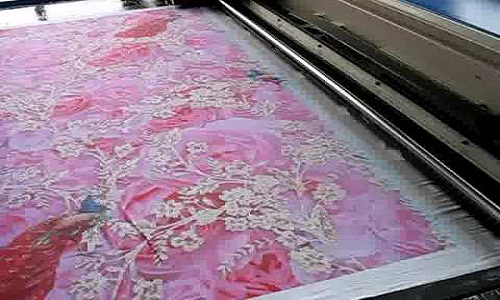
Said, Smarth Bansal, Brand Manager, ColourJet that the Indian market has taken to digital textile printing and a lot of Indians across the world are buying the most expensive machines. The machines don’t use as much water as traditional printing uses. So this is a big reason for people to convert. And shorter print runs are possible. You can have a number of designs. You can have low inventory management. So we are happy with the Indian and international markets.
Water and waste management
European markets have the largest share of digital printing in the pie because of the strict laws on water saving and waste management. And these machines do exactly that. So they have taken to this technology in a very big way. But in India people evade these issues and stick to traditional printing. But the market will grow in India because India is the second largest textile exporter.
Fashion apparel means a lot of new designs a day. This is possible with digital machinery. Bansal believes in approving one design from 70 odd design options. That’s the main reason digital textile printing is in vogue. Moreover, home furnishing sector have inventory management issues. That’s why they have adopted digital textile printing.
Digital machines have an advantage when it comes to indirect cost like waste management, water use, and inventories. Anything on screen printing needs a huge amount of inventory. You have to have huge amounts of print runs. But in digital you can give a command for even ten meters. So your inventory level goes down. Your stocks go down. You can produce more number of prints and designs for your customers. It is true that with digital machines you need the numbers. The machine cost is a big capital investment. So we feel you should buy the machine only if you have a decent production. There are people who buy even for sampling because sampling is also a big job.
Enabling sustainability
According to Sri, Director South Asia-Veit Machine, the garment industry is reviving. Markets like Vietnam, Bangladesh, Indonesia, Sri Lanka are coming up well. People are more toward technological up gradations, conserving energy, investing in solar panel installations. Garment sourcing is happening from south Asia. Earlier suits were made only in Europe for quality reasons. Now they are confident countries like Vietnam, Bangladesh have the technology and skill levels. So there is a volume shift to these markets.
Production costs in China are becoming substantially higher than the other markets. But China will remain the biggest apparel manufacturer because of its domestic consumption. But production of shirts, suits which don’t have much fashion changes has started moving out of China. That has flooded the market in Sri Lanka, Bangladesh, and Vietnam. Even in India to a certain extent we could see an inflow of shirts for export. China has become considerably expensive not only because of the operating cost but because of the devaluation of the currency. This made it more expensive to produce in China.
The garment industry has been forced to take up technological advancements. Earlier the industry was not too keen on taking up technology. They looked at the accounts and not really at the overall picture. Contract labour was hired. Issues like skill they never considered. So people are now looking at technology to reduce their dependence on contract labour. Technology is not only about upgrading labour but also about saving power and enabling sustainability.
Sunder Belani, Managing Director of Ramsons is of the opinion that people are looking at sustainability, saving energy, water, reducing chemicals in the wash cycle and reducing carbon footprint. They are looking at better standards of working. They want to standardize compliance systems. Technology is not just to reduce manpower, it’s also to give a better quality and automated systems, he concluded.
Off Price New York will take place on May 2 and 3, 2016. This is a market-sized fashion and apparel tradeshow. It is a dynamic order writing show that connects apparel retail buyers of all sizes with leading off-price specialists in 20 to 70 per cent below wholesale apparel, accessories, footwear and more.
The show offers 68 booths of men’s, women’s, and children’s apparel and accessories. All the categories are well represented and there are opportunities for the entire family.
This is an intimate show where people can really sit down, evaluate opportunities, look for matches, have the opportunity to talk about things, try new things in their store, and see what everyone is offering. It’s also an opportunity to find trends that may have been missed, and to spend more time discussing options.
Off-price retailers sell clothing and accessories ranging from major label brands to private label, non-branded goods at a significant discount. When a designer or manufacturer produces more clothing than it can sell through specialty retailers or department stores, or a store can’t move all of the items in a particular line, the excess inventory is sold at a 20 to 60 per cent discount to an off-price retailer.
www.offpriceshow.com/newyork/show-dates-hours
In its 14th annual conscious actions sustainability report published recently, Hennes & Mauritz (H&M), the Swedish fast-fashion giant claimed that 78 per cent of its electricity used came from renewable sources in 2015, up from 27 per cent in 2014. At the same time, its total emissions were reduced by 56 per cent. Last year, H&M collected 12,000 tons of textiles for reuse through its in-store garment-collection program. That’s the equivalent of 65 million T-shirts.
According to Cecilia Bransten, H&M’s sustainability business expert, when it comes to engaging their customers, the garment-collecting initiative is actually the second most well-known sustainability initiative that they do, aside from their conscious collection. H&M reported that sustainably sourced materials made up 20 per cent of the total material it used, up from 14 per cent in 2014. Organic cotton, recycled cotton and Better Cotton (certified by the Better Cotton Initiative) represented 31.4 per cent of H&M’s cotton intake in 2015, versus 21.2 per cent in the previous year. The company’s goal is to only use cotton from sustainable sources by 2020 and set a timeline which will determine when they will reach a stage of using 100 percent recyclable and sustainable sources of materials. Meanwhile, with its reprocessed polyester products, the brand recycled the equivalent of 90 million PET bottles.
Canopy works to protect the world’s forests by collaborating with business leaders, scientists and decision-makers to help create sustainable supply chains and foster innovative solutions to environmental challenges. Canopy creates brand partnerships based on a policy. There is no cost to join the organization, which 105 brands and retailers have done. The movement toward a more sustainable apparel and textile supply chain has evolved in the last decade or so.
This ranges from improving the environmental impact of raw materials and manufacturing to the advent of recycled materials used in fibers and fabrics, and reuse of textiles and apparel. Technology is helping companies better trace their suppliers and manufacturers, and collaborative efforts have emerged to create more transparency and better methods of ensuring a safer route from factory to retail shelf.
Companies are creating systems and programs to achieve the goals of circularity, which brings the added benefit of avoiding compliance risks and costs in the overall product development and production process. Sustainability empowers organizations to protect the well-being of workers, reduce risk, improve productivity, enhance compliance, and drive measurable business improvement.
A growing number of businesses see the risks posed by the linear economy as an opportunity, and are preparing to progress towards a circular economy, where products and the embedded resources within them are used at maximum capacity and then regenerated at the end of their use phase for further life cycles.
The International Apparel Federation (IAF) together with Spesa and Messe Frankfurt is hosting a panel discussion at the Texprocess Fair in Atlant, Georgia on May 2, 2016. Moderated by IAF's Matthijs Crietee, the theme of the discussion will be on ‘How technology is implemented across the globe increase productivity in the apparel industry,’ which will be a fixed item on IAF’s and Messe Frankfurt’s calendar. The concept is that IAF members from all continents join in the discussion around an apparel technology management oriented theme.
In the panel discussion, the organizers will explore the most promising technologies to improve productivity. They will discuss how in different parts of the world technology is being used to improve productivity and if this is all new technology, or sometimes simply a reuse of existing methods. And specifically, the panel will explore how far automation will have proceeded in 2020. Now that the organizers can see examples of the fashion industry returning to high cost locations, leading to trends such as reshoring or newshoring, they wonder how technology is enabling these trends.
The panelists will include: Dave Gardner (Spesa), John Stern (Methods Workshop), Han Bekke (MODINT), Stefanon Festa Marzotto (Sistema Moda Italia and FBS), Mike Fralix ([TC²]), Van Tucker (Nashville Fashion Alliance), Ed Gribbin (Alvanon), Murat Aydin (TCMA and Modega) and Geoff Willis (Trigon Select).
Sri Lanka’s exports fell 2.5 per cent in January but industrial exports rose led by apparel and rubber, while imports continued to fall. Apparel exports rose 13 per cent and rubber exports rose 11 per cent. Imports were down 5.5 per cent with vehicle imports down 13 per cent.
The trade gap fell 9.1 per cent in January 2016 from a year earlier. Sri Lanka has a trade gap because the country has foreign exchange earnings beyond merchandise good exports including remittances and tourism. Imports are also driven by net foreign borrowings.
In 2015, exports fell 5.6 per cent and imports fell 2.5 per cent with remittances and inflows falling. But the country experienced a balance of payments deficit and a currency crisis as money was printed to finance the deficit and to enforce a rate cut as credit recovered. The printing of money prevented imports shrinking in line with the weakening net capital inflows.
In Sri Lanka mercantilism is ingrained and most people believe that currency troubles are not a result of monetary instability but due to the trade deficit, particularly oil or car imports. This year oil could not be blamed as oil prices collapsed. Mercantilist beliefs in Sri Lanka blame diesel in particular for inflation. Due to the prevailing mercantilism the central bank has been able to print money, generate inflation or currency collapses and get away with it, though it is getting increasingly harder.
"Myanmar’s clothing industry is set to grow tremendously in the coming years, according to a report in the latest issue of Global Apparel Markets from the business information company Textiles Intelligence. Freedom from military rule and reformist government policies are making things possible"
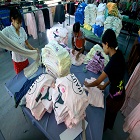
Myanmar’s clothing industry is set to grow tremendously in the coming years, according to a report in the latest issue of Global Apparel Markets from the business information company Textiles Intelligence. Freedom from military rule and reformist government policies are making things possible.
Myanmar a sourcing destination for brands
A turning point came on March 30, 2011, when a reformist president, Thein Sein, was sworn in as the leader of a military-civilian government. That is when would be-investors and garment sourcing companies based in the West started to turn their attention to Myanmar. The first Western brand to source from Myanmar was H&M in 2013 followed by Gap in 2014 and these companies appear to have paved the way for others to follow. Experts predict that there could be upto 1.5 million jobs in the garment industry by 2020 compared with approximately 230,000 in mid-2015, and that garment exports could rise from $1.5 million in 2014 to as much as $12 billion in 2020.
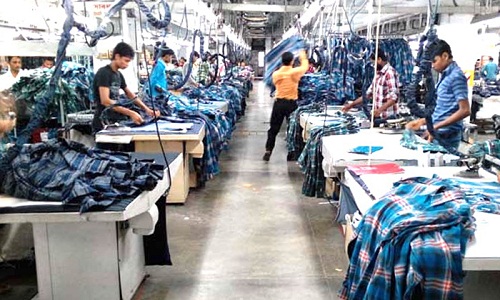
Prior to 2011, Myanmar had been subject to 50 years of military rule which made it a very poor country, plagued by bureaucracy and corruption, and isolated by international sanctions. But most of the sanctions have been removed in recent years and many countries have granted free trade or preferential trade status to clothing made in Myanmar.
Furthermore, foreign direct investment (FDI) in the garment industry has been growing at an impressive pace in recent years and, following the removal of sanctions, clothing exports from Myanmar shot up by 26.5 per cent in 2013 and by a further 27.4 per cent in 2014.
To plan for expansion, the Myanmar government has published a strategy for the textile and garment industry as part of a document entitled ‘National Export Strategy 2015-2019’. In particular, the industry has been advised to: move from operating on a cutting, making and packaging (CMP) basis to operating on an fob (free on board) basis; increase volume; improve quality; produce a greater volume of knitted products
Meanwhile, investments have gone into infrastructure like roads and ports in the country, and initiatives are being pursued to improve the industry’s international competitiveness and encourage sustainable production.However, experts opine that the country has outdated machinery, inadequate infrastructure and a banking system which remains ill-equipped to provide services to local citizens, let alone global companies.
Almost all the fibres used by Myanmar textile industry need to be imported as natural fibre production in the country is negligible. Furthermore, the industry lacks vocational training programs, and demand from Western retailers is unlikely to increase at a rapid pace as buyers are expected to proceed cautiously.
Consequently, the industry will need modern machinery, raw materials, skilled labour, social and environmental certification, energy sources which are reliable, a logistics infrastructure and a financing system which runs smoothly
According to the ‘Alliance’, a group of North American buyers, only 24 garment factories in Bangladesh are fully remediated, while more than half of the initially-identified flaws have been repaired. The group of 28 brands including Gap and Wal-mart said it has so far assessed fire, electrical and structural integrity of a total of 700 units.
The group also said explaining the progress half-way through its five-year tenure, that it also referred 36 factories to the official review panel after finding them ‘structurally unsafe,’ while suspended business with 77 units that failed to carry out the required remediation.
According to Ian Spaulding, Senior Advisor to the Alliance, a total of 24 factories have been fully remediated. We have verified that more than 49 per cent of all required repairs have been completed till date. That means that out of 48,500 issues identified during its inspections, more than 23,000 have been verified as being addressed or closed out, he explained.
After the Rana Plaza building collapse, global brands formed two groups-Accord and Alliance- following the outrage and assessed some 2,000 garment factories out of 4,500 garment units.












